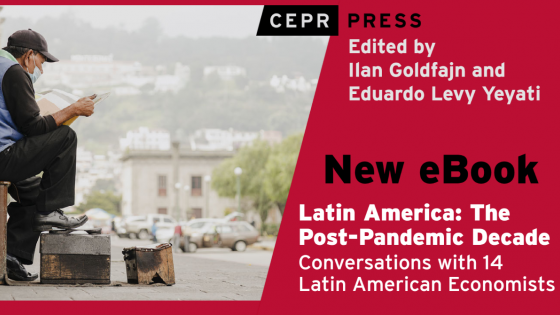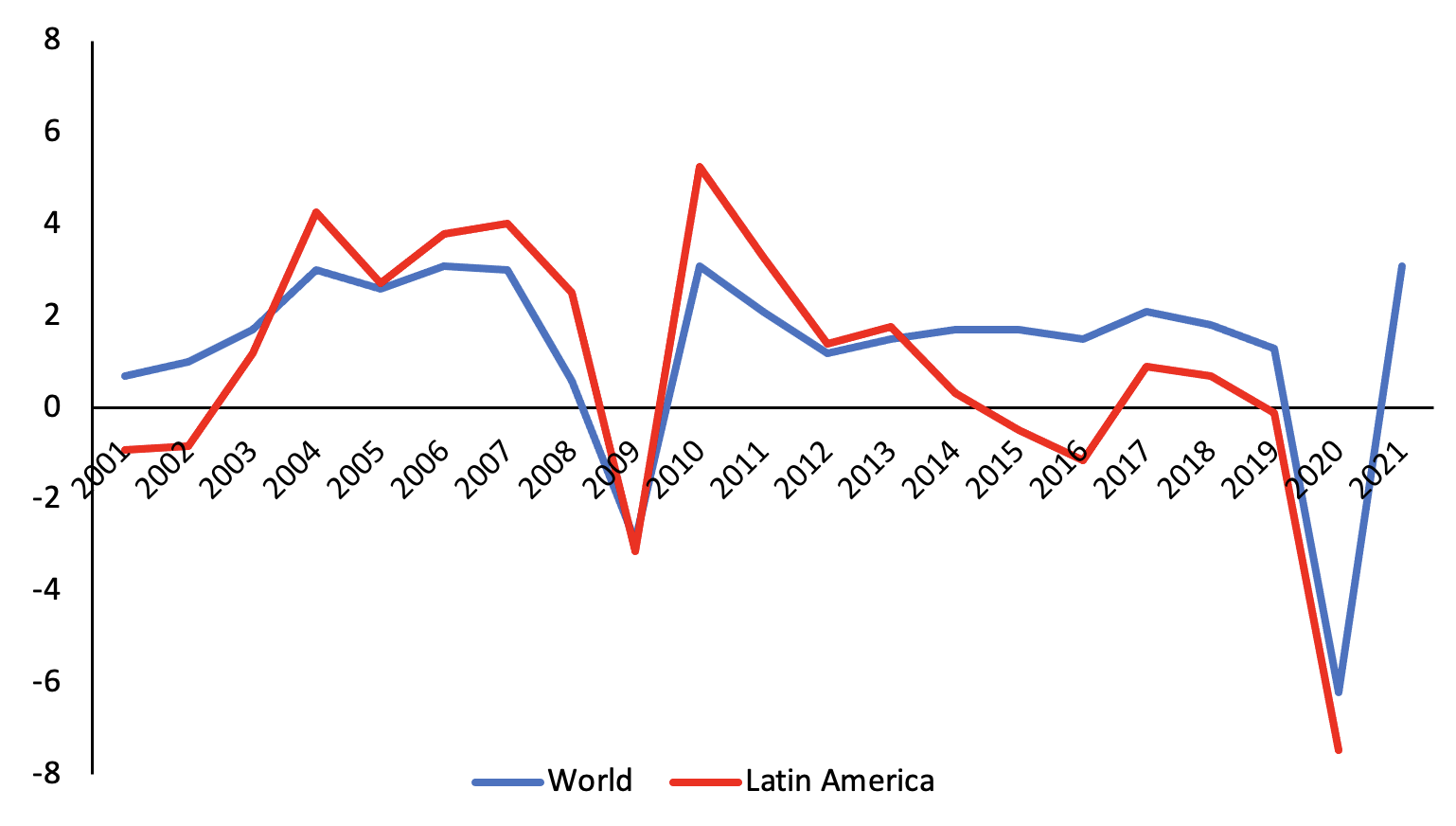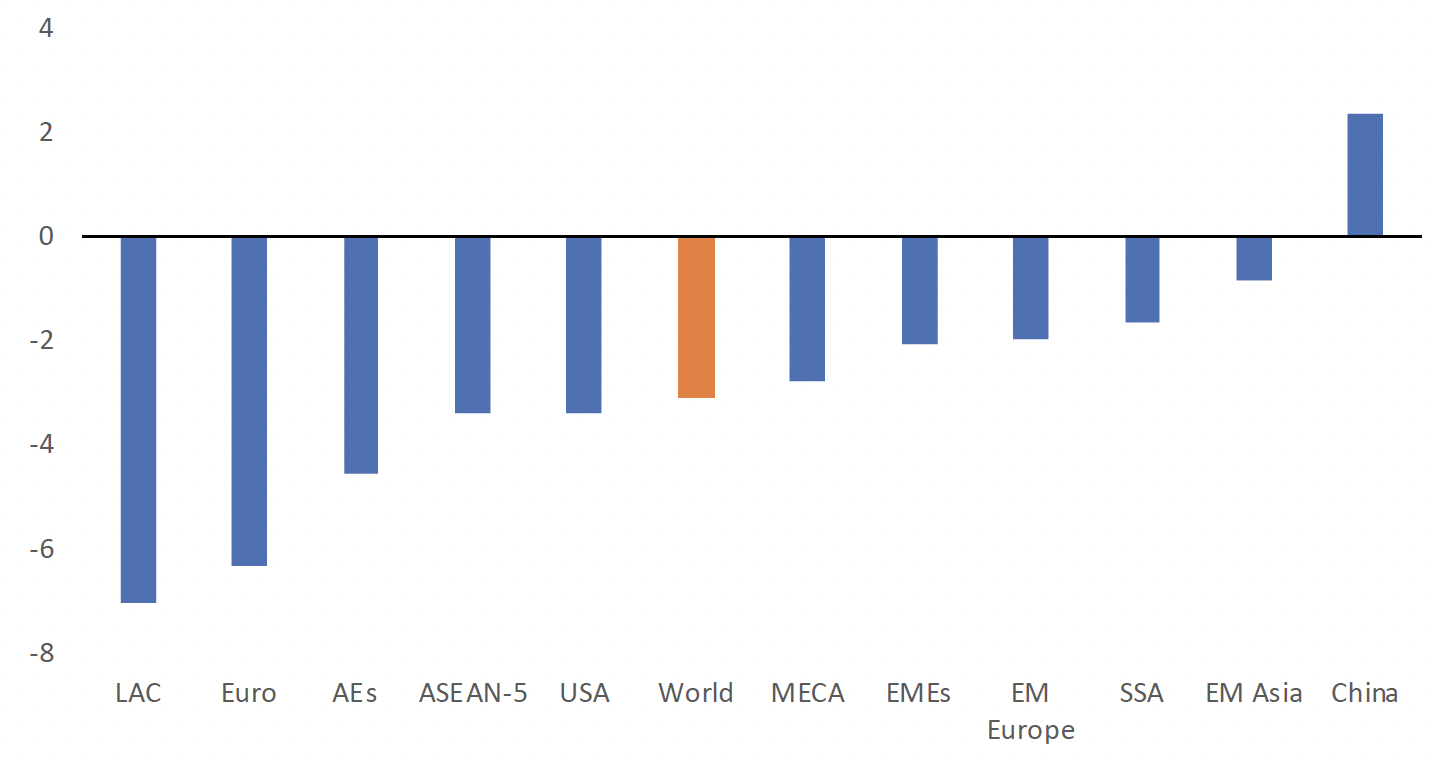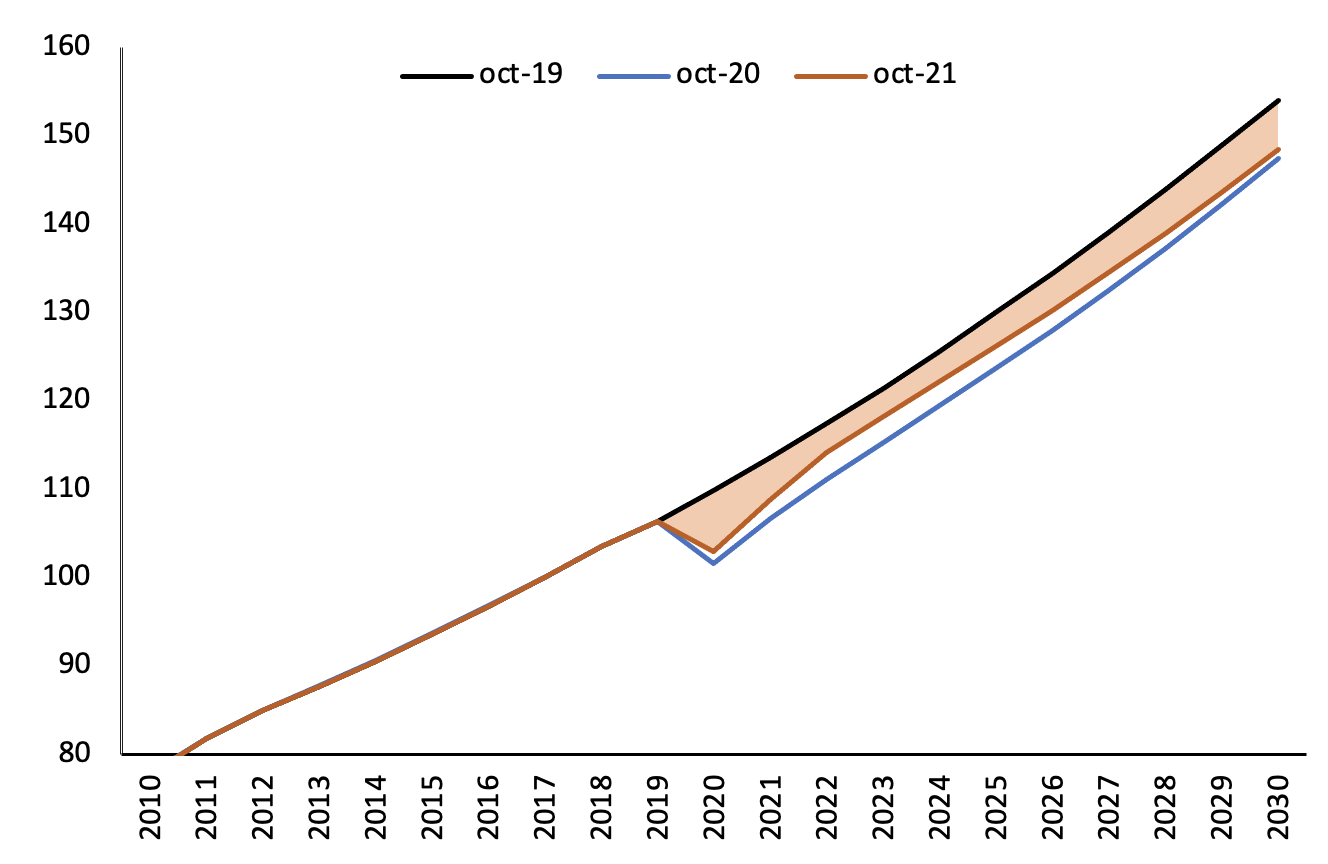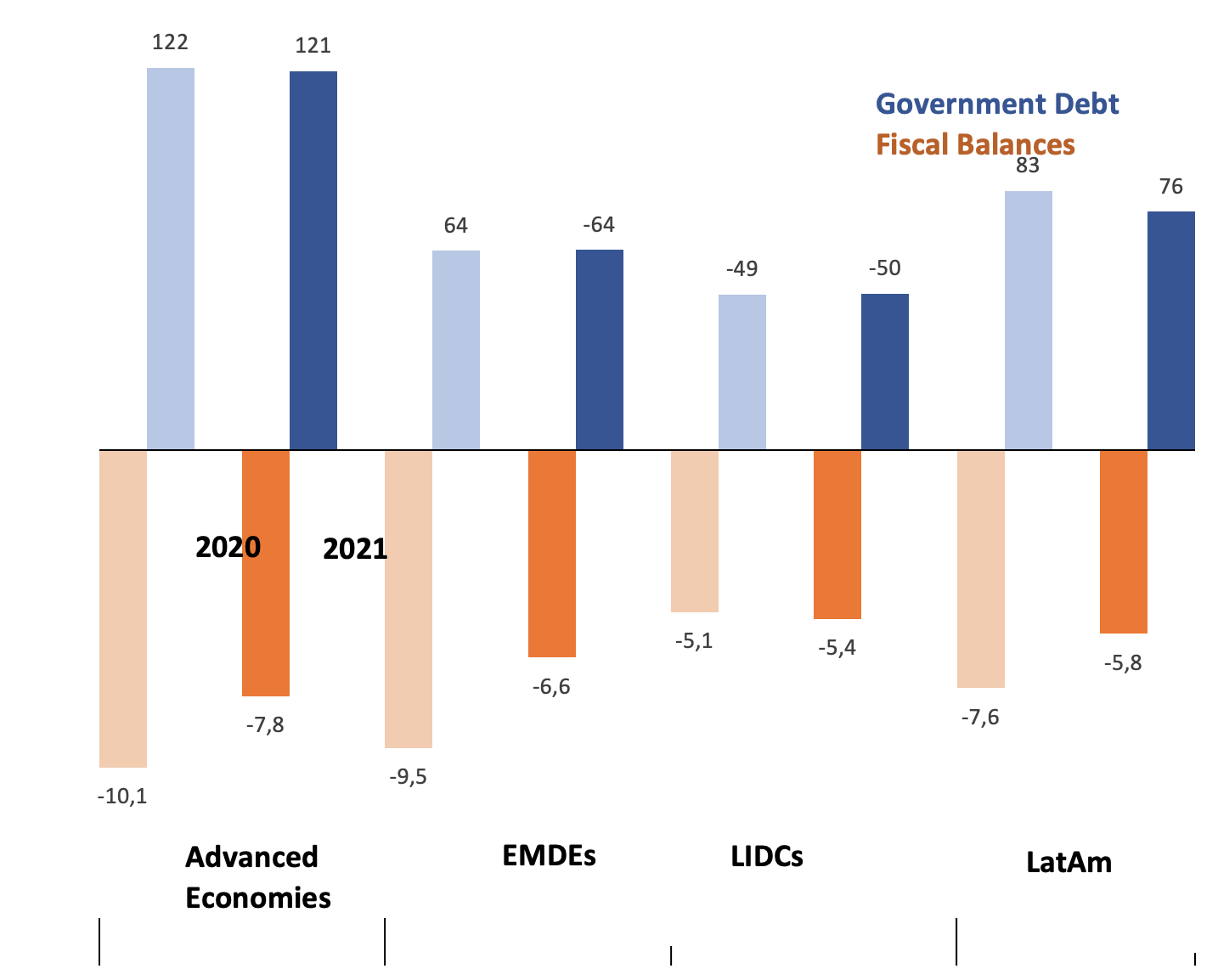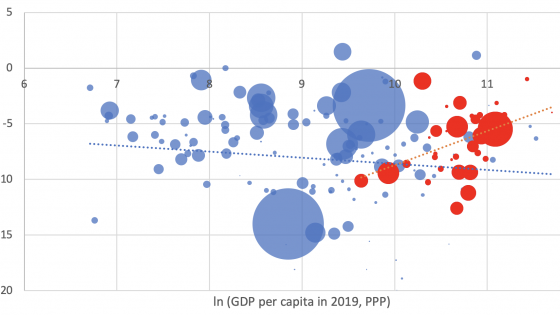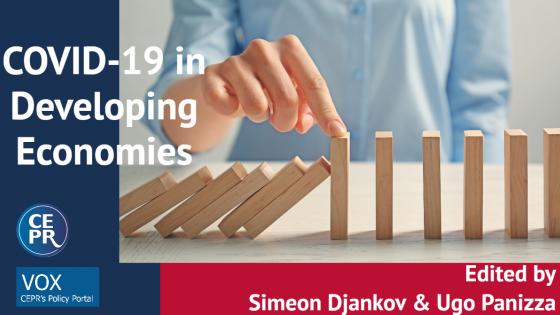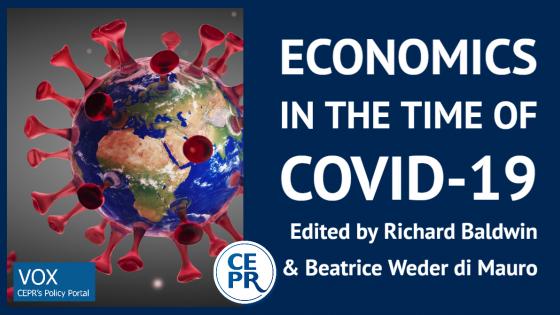In April 2019, the IMF revised global growth down by 6.3% relative to its March (pre-Covid) forecasts. While uncertain and dependent on the policy response, experts have pointed to the possibility of permanent output losses since the beginning (Baldwin and Weder di Mauro 2020), with a more deleterious impact on developing economies (Djankov and Panizza 2020, Levy Yeyati and Filippini 2021). The Covid-19 shock could be interpreted as a combination of supply and demand shocks, with the supply shock driven by the restriction of activities due to lockdowns and distancing measures to contain the spread of the virus, and the demand shock reflecting both the income effect suffered by workers in restricted activities, as well as the diminished mobility and changes in consumption patterns due to contagion concerns (Guerrieri et al. 2020, IMF 2020, Simola 2021).
For Latin America, the Covid-19 pandemic came at an inconvenient time and on top of chronic problems. It hit the region after years of mostly lacklustre growth compared with global averages (Figure 1), and at a time when the gains in terms of poverty and inequality had been tapering off and governments were finding social expectations increasingly harder to meet. As a result, the downturn was more pronounced (Figure 2) and long-run damages – for example, those associated with education losses or job destruction – will likely be larger and more persistent. The pandemic also flagged two long-standing but often overlooked regional deficits: poor state capacity, and labour exclusion and informality. This explains the region worse performance during the pandemic: larger welfare costs and meagre relative recovery. Not surprisingly, societies face growing indifference with political regimes (Latinobarómetro 2021), and social outbursts in several countries, such as Chile or Colombia, reveal dissatisfaction which will likely limit economic policy looking forward.
Figure 1 Global and Latin American growth from a historical perspective
Source: Levy Yeyati and Filippini (2021b) based on IMF WEO October 2021 and The World Bank World Development Indicators. Note: Data for 2021 are forecasts.
Figure 2 Global GDP growth 2020
Source: Levy Yeyati and Filippini (2021c), based on IMF-WEO Oct-2021.
Note: AE = Advance economies; EM Asia= emerging and developing Asia excluding China; EM Europe = Emerging and developing Europe; LAC = Latin America and the Caribbean; MECA = Middle East and Central Asia; SSA = sub-Saharan Africa.
Against this backdrop, a new CEPR eBook collects a series of conversations with distinguished Latin American researchers and policymakers aimed at trying to map a possible future for Latin America (Goldfajn and Levy Yeyati 2021).
Download Latin America: The Post-Pandemic Decade. Conversations with 16 Latin American Economists here.
While the global economy is already recovering – indeed at a faster pace than originally predicted (as Figure 3 illustrates, forecasts were revised upward, particularly for advanced countries) – the global rebound masks important cross-country differences. Updating the methodology used in OMS (2021) to the latest growth revisions, a back-of-the-envelope estimate based on the IMF’s pre-Covid and latest projections shows that in Latin America the expected output loss – as measured by the present value of the difference between pre- and post-pandemic growth forecasts for 2020–30 – will be roughly 76% of 2019 GDP, or nearly 70% larger than the global one. And there were many additional costs, including education losses, excess deaths, and job and firm destruction, that were more pronounced for low- and middle-income households and countries (OECD 2020).
Figure 3 Global GDP projections (constant USD, index 2017=100)
Sources: IMF World Economic Outlook October 2019, October 2020 and October 2021.
Unlike the global financial crisis, when monetary policy bore the greatest share of the burden, the Covid shock triggered an unprecedented fiscal response from governments across the globe. The fiscal dimension was, and will remain, crucial to analyse the differential impact of the crisis across regions. The increase of the fiscal deficit in advanced economies doubled that of emerging and middle-income countries, and was five times larger than that of lower-income economies – a sizable fiscal effort that, coupled along with the contraction in output and fiscal revenues, led to an increase in government debts (Figure 4).
Figure 4 Fiscal response
a) Forecasts for general government gross debt and fiscal balances (as a percentage of GDP)
b) Government debt (as a percentage of GDP)
Note: EMDEs = Emerging Market and Developing Economies, LIDCs=Low Income Developing Countries, LatAm=Latin America and the Caribbean excluding Argentina and Ecuador. Aggregates calculated using current GDP in U.S. dollars as weights except for Latin America, where aggregation is a simple average.
Source: World Bank January 2021 World Economic Prospects and October 2021 World Economic Prospects, and IMF Fiscal Monitor. Data for 2021 is estimated.
The effectiveness of these fiscal stimuli is still not clear. Overall, the capacity of countries to implement emergency measures varied significantly. Three dimensions, already relevant prior to the pandemic, crop up over and again in the conversations in the eBook to account for this heterogeneity:
- Fiscal space. The capacity to support household and firms largely depends on fiscal space to spend from budget and/or access to financing, either domestically or in international financial markets. Several Latin America countries had a lack of fiscal capacity.
- The capacity of the state to reach the affected population. Fast and efficient implementation of policies to support household and firms requires information and ‘capillarity’ of institutions, organised and up-to-date databases on low-income individuals and those in poverty, and a good tracking of the population that moves into poverty and needs help as a result of the shock.
- The precarity of labour markets (informality). Informal workers tend to rely on face-to-face interactions and faced significant difficulties adapting to remote working, which meant that a large share of informal workers ere immediately thrown into poverty, with limited capacity of the state to reach them.
The political dimension will remain key. The effectiveness of both the lockdowns and the fiscal response were conditioned by political factors. On the one hand, many countries came from a period of increased civil unrest that reduced the government’s ability to restrict mobility. On the other hand, lack of political cohesion made it more difficult to implement restrictions, which inevitably led to lockdown fatigue and declining compliance. On top of that, a background of discontent and/or ongoing recessions clouded any perception of an effective pandemic response. Polarisation in politics, and society in general, seems to be a relevant blocking stone to address the challenging economic environment going forward.
The pandemic left us with three monetary/financial risk fronts of future concern: (i) non-performing loans (NPLs) when borrowers have to repay their Covid-related loans or catch up with loan extensions; (ii) potential pressures to engineer seemingly easy monetary solutions to hard fiscal problems, either by monetising deficits or by using financial repression to channel scarce resources to meet government needs; and (iii) the consequences of tightening monetary policy – locally and globally – in a context of persistently higher inflation. Indeed, unprecedented fiscal and monetary stimuli could have led to a permanent – or at least very persistent – inflation push, both globally and locally in the region.
In sum, the combination of pre-existing conditions and the large Covid shock in a context of polarised political societies poses a set of challenges for Latin American policymakers and politicians that include, but are not restricted to:
- Economic and political constraints to fiscal policy. The combination of higher debts and more financing needs, at a time when there is still a need to provide stimulus to the ongoing growth recovery and support to make up for the losses of a large share of the population, certainly creates a political dilemma. This complicated fiscal trade-off and the need to contain the primary deficit will surely fuel the debate on the size of public sector, pointing at the need to scale it down through spending cuts where it is needed (most notably, Argentina and Brazil) or to scale it up through tax hikes for the affluent – and, more realistically albeit tougher, the middle classes – pretty much everywhere else in the region.
- Populist temptations in economic policy. The scarcity of resources, coupled with an abundance of needs, could lead to economic populism. This narrative – that there are no objective constraints to the use of fiscal resources – is not new in Latin American. Similarly, populism may propose monetary financing as an easy and sustainable solution to the fiscal dilemma. Polarised societies and political segmentation magnify the risk of populist temptations.
- Asymmetric consequences of the pandemic. As the shock affected different groups asymmetrically – informal more than formal workers; lower-middle-income households more than the middle and upper classes; women more than men; contact-based, bricks-and-mortar activities more than digital services – social cohesion will be challenging. In particular, policies during the recovery from the crisis should not be neutral; special attention should be assigned to the groups most affected by the pandemic.
Section I of the eBook, “Avoiding the next crisis”, brings together contributions from Laura Alfaro, Roberto Chang, José de Gregorio and Federico Sturzenegger, centring on crisis management, lessons learned from the Covid shock and policies to avoid the next crisis, with a focus on the fiscal and debt fronts.
Section II, “Policies for sustainable growth”, includes dialogues with Marcela Eslava, Ricardo Hausmann, Rodrigo Valdés and Alejandro Werner on the causes of the dismal growth performance of Latin America and the post-Covid policies needed to change this reality. The contributors in this section suggest that the region will witness important, albeit short-lived, rebounds in 2021-2022 but argue that, if global financial conditions become less supportive, the next decade could be quite demanding, particularly in light of the significant and persistent scars from the Covid crisis.
In Section III, “Social challenges ahead”, Francisco Ferreira, Nora Lustig and Eric Parrado focus on the social aspects of the Covid crisis, its impact and challenges. They argue that the pandemic increased poverty and inequality along several dimensions, as those living in poorer areas, informal workers and minorities suffered the most. This has deepened – but not altered – Latin America’s key social policy challenges and priorities, including tax reforms to allow for a socially responsible way fiscal consolidation.
Finally, in Section IV, “The future of democracy in Latin America”, Edmar Bacha, Armínio Fraga, Andrea Repetto and Andres Velasco reflect on the protests and social discontent in the region, the noisy and unstable political environments (and what to do about them) and, more generally, on whether and to what extent this aspect may become a relevant driver of and a binding constraint on the Latin American post-pandemic landscape. The contributors (i) argue that the social indicators of the last 30 years do not correlate with the growing perception of inequality, (ii) emphasise that the tolerance for income inequality and unfairness declines in the course of development, (iii) highlight that political and economic reforms that put the general interest first in providing goods and services that are essential to the public are badly needed to repair these problems, and even (iv) speculate that the region will end up reinventing social democracy in a way that addresses the demand for growth that is sustainable in all senses of the word – financially, environmentally and socially – although success is far from assured.
Is Latin America doomed to another lost decade?
We believe it is too early to tell. And we hope not. The difficulties ahead call for a reaction, as the proposed solutions cannot be seen as a repackaging of the old formulas that brought us here. Otherwise, social frustration will continue to fuel civil discontent and to promote short-sighted populist agendas. There is also a risk that current tensions could lead to the undoing of past improvements in achieving stability. It is politically tempting to disregard the benefits of running responsible monetary and fiscal policies, or the relevance of a focus on productivity, innovation and competitiveness as pillars of sustainable progress.
People’s willingness to engage in reforms depends on their perceived fairness. This perception requires effective communication, as well as a true commitment by the region´s established and new leaders. Given the complex task and numerous constraints discussed in detail in these dialogues, there is a clear danger that voters and politicians yield to easy near-term shortcuts that would ultimately lead to loss of income, higher inequality and poverty – a major detraction from welfare in the long-term. Latin America is at a crossroads. Whether or not we avoid another lost decade will depend on the choices the region makes today.
References
Baldwin, R and B Weder di Mauro (2020), “Economics in the time of COVID-19: A new eBook”, VoxEU.org, 6 March.
Djankov, S and U Panizza (2020), COVID-19 in Developing Economies, CEPR Press.
Goldfajn, I and E Levy Yeyati (2021), Latin America: The Post-Pandemic Decade. Conversations with 16 Latin American Economists, CEPR Press.
Guerrieri, V, G Lorenzoni, L Straub and I Werning (2020), “Viral recessions: Lack of demand during the coronavirus crisis”, VoxEU.org, 6 May.
IMF (2020), World Economic Outlook, October 2020: A Long and Difficult Ascent.
Latinobarómetro (2021), Informe Latinobarómetro 2021: Adiós a Macondo.
Levy Yeyati, E and F Filippini (2021a), “Pandemic divergence: The social and economic costs of Covid-19”, VoxEU.org, 12 May.
Levy Yeyati, E and F Filippini (2021b), "Pandemic divergence: A short note on COVID-19 and global income inequality," School of Government Working Paper 6/2021, Universidad Torcuato Di Tella.
Levy Yeyati, E and F Filippini (2021c), “Social and economic impact of COVID-19”, Brookings Global Working Paper # 158, June.
OECD (2020), Tax Administration Responses to COVID-19: Measures Taken to Support Taxpayers, OECD Publishing, Paris.
Simola, H (2021), “Consumption and service sector demand played a key role in the COVID-19 global trade collapse”, VoxEU.org, 24 November.
